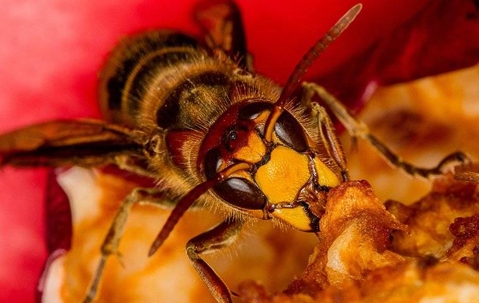Wasps In Chicago: What They Look Like And Where To Find Them
Of the thousands of species of wasps in the United States alone, seldom few can be found near civilization, and even fewer are seen in Chicago:
- Yellowjacket – ½ of an inch long, hairless, black and yellow stripes, build nests underground and within shelters
- Cicada Killer – 2 inches long, hairless, dark brown to black with yellow stripes, solitary ground nesters
- Mud Dauber – ½ to 1 inch long, hairless, color varies between black and yellow stripes, completely black, or metallic blue, nests are mud tubes often built in sheltered areas
- Bald-faced Hornet – ½ to 5/8 of an inch long, covered in small fine hairs, black and pale white stripes, nests are aerial and paper-like
- Paper Wasp – ½ to 1 ½ inches long, hairless, coloring varies between orange, reddish brown, and dark red, nests are aerial and paper-like
You may be wondering why bald-faced hornets are included with wasps. Truthfully, these insects aren't technically hornets at all; but rather a different and more aggressive species of yellowjacket. Some of these species are much less aggressive than others, such as mud daubers and cicada killers, but make no mistake, they're all still very dangerous to have around your Chicago property.
The Life Cycles And Activities Of Wasps In Chicago
The wasp life cycle is truly fascinating, especially since they spend the majority of their changes in one single colony cell. After the queen lays her eggs, one in each cell, the other worker wasps spend their time building new cells and eventually foraging for food to feed the newly hatched larvae. When they've grown to their full size, the workers seal the cells, and the larvae solidify into pupae to finish their metamorphosis. Once fully grown, they emerge from their pupa shells as adult worker wasps, ready to work tirelessly for their queen.
As for daily activities, wasps are often found up to 1000 yards away from their nests as they search for food and materials to build their nests, which are often found:
- Hanging from trees
- Hidden in bushes
- Sheltered under roofs such as gazebos and patios
- Within tree voids, dead logs, and inside wall voids
- Underground; inside old rodent nests or self-built
How To Safely Remove A Wasp Nest From Your Chicago Property
The absolute safest method to remove a wasp nest from your Chicago property is to call your local pest control company. Wasps are incredibly dangerous insects, especially since they can sting multiple times, and making an entire nest angry with DIY methods and unreliable store-bought pesticides is a surefire way to get sent to the ER. Dangerous pests like these are best left to the professionals, like Aerex Pest Control.
As a family owned and operated company since 1948, we work hard to keep our customers safe and 100% satisfied with our services. We're meticulous about what technicians we hire and we're dedicated to offering effective and affordable pest control. We only ever use top of the line pest control products, and our 100% satisfaction guarantee ensures that your home will stay pest-free. Get in contact with us today to start discussing your pest control options.

